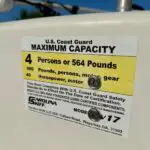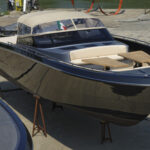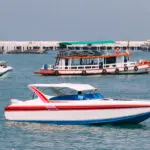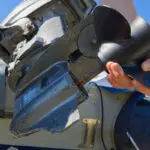When choosing a trolling motor for Carolina Skiff boats, the essential factor is the required thrust, as your motor should be strong enough to propel your boat’s weight.
You’ll need roughly 2 lbs. of thrust per 100 lbs. of the boat. Another critical consideration is the motor’s shaft needs to be long enough.
Like with many life decisions, size does indeed matter! Selecting the correct size trolling motor for your Carolina Skiff is critical.
Below we’ll investigate the recommended size trolling motors for the various skiff sizes, the best trolling motor for a Carolina Skiff, and other essential aspects.
This post may contain affiliate links. As an Amazon Associate, I earn from qualifying purchases
Table of Contents
- Selecting The Correct Size Trolling Motor For A Carolina Skiff
- What Are The Advantages Of Using A Trolling Motor?
- What Are Some Limiting Factors When Using A Trolling Motor?
- Frequently Asked Questions About Trolling Motors For Carolina Skiffs
- What Happens If My Trolling Motor Is Too Big For My Carolina Skiff?
- Can A Trolling Motor Be Too Small For A Carolina Skiff?
- Should You Put A Trolling Motor On A Carolina Skiff?
- When Would I Use A Trolling Motor On My Carolina Skiff?
- Can You Equip A Trolling Motor To A Carolina Skiff?
- What Is The Best Brand Of Trolling Motor?
- Does More Thrust Mean More Speed?
- Related Posts
Selecting The Correct Size Trolling Motor For A Carolina Skiff
Choosing the correct size trolling motor is paramount to the effective operation of your vessel.
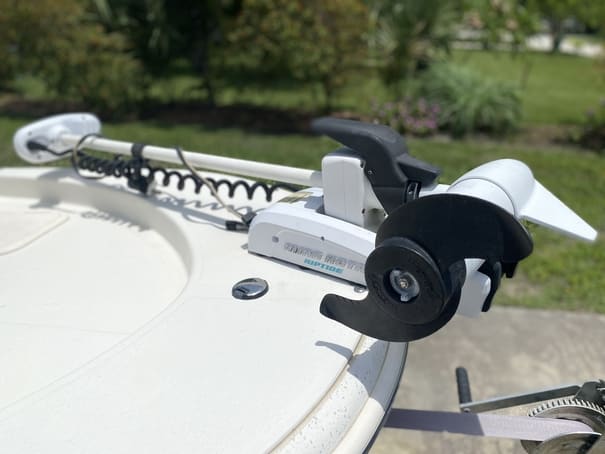
The size and shape of your boat, the area you’re operating in, and your intended usage, play pivotal roles in influencing your purchasing decision.
Trolling Motor Shaft Length For Carolina Skiff
The length of the shaft on your trolling motor depends significantly on how deep you plan to use it and on the sitting bow/transom height of your boat.
For example, if you want to troll in the shallows, you’ll need to ensure that the motor’s shaft is long enough to reach from the mounting position on your boat to the water without protruding too far under the hull.
While the prop must be submerged, you’ll hit mud and rocks of the waterbody substrate if it’s too deep.
Shaft length requirements in bow-mounted trolling motors:
- A 36-inch shaft length for bows 0 to 16 inches above the water.
- 42 to 45-inch shaft length for bows 16 to 22 inches above the water.
- 46 to 52-inch shaft length for bows 22 to 28 inches above the water.
- 53 to 62-inch shaft length for bows 28 to 34 inches above the water.
- A 72-inch shaft length for bows 34 to 44 inches above the water.
- An 87-inch shaft length for bows 44 to 64 inches above the water.
Shaft length requirements for transom-mounted trolling motors:
- 24 to 30-inch shaft length for transoms 0 to 10 inches above the water.
- 30 to 36-inch shaft length for transoms 10 to 15 inches above the water.
- 36 to 40-inch shaft length for transoms 15 to 20 inches above the water.
- 40 to 42-inch shaft length for transoms 20 to 25 inches above the water.
Best Trolling Motor For Carolina Skiff
There is no one-size-fits-all when considering trolling motors.
The length and shape of your hull, the mounting area (bow or transom), the prevalent water conditions, and the required run-time contribute significantly to the size motor you require.
For example, on my Carolina Skiff JV17 , I use a 12 volt Minn Kota Riptide that is 55 lb thrust with a 48″ shaft.
The best motor for the job is powerful enough to hold your skiff steady in gentle waters or move it at a slow speed, especially when fishing or docking.
However, there are some rules to help you determine the required size:
As a general guideline, for every 100 lbs of the boat, you’ll need 2 lbs of thrust.
The equation looks like this: (Y/100) X 2
(Where Y is the weight of your boat). The larger and heavier the boat, the more thrust (and voltage) you’ll need to move your boat.
Note: remember to calculate your boat at its fully loaded weight (gear, fuel, provisions, etc.)
Most trolling motors are either 12V, 24V, or 36V. The greater the voltage, the greater the thrusts.
As a general guide to the amount of thrust required:
- Boats requiring up to 55lbs = 12V motors
- Boats requiring between 55 lbs. and 80 lbs = 24V motors
- Boats requiring between 80 lbs. and 115 lbs = 36V motors
Below is an approximate guide for the size of the trolling motor required to propel the various currently available Carolina Skiffs.
These are not maximum weights (no gear added).
| Carolina Skiff Model | Relative Weight (lbs.) | Minimum Thrust Requirement (lbs.) | Recommended Minimum Trolling Motor Size |
| 162 JLS | 1372 | 55 | 12V |
| 178 JLS | 1400 | 55 | 12V-24V |
| 192 JLS | 1716 | 55 | 24V |
| 17 LS | 1700 | 55 | 24V |
| 19 LS | 1900 | 55 | 24V |
| 21 LS | 2100 | 55-80 | 24V |
| 23 LS | 2550 | 80 | 24V |
| 25 LS | 2700 | 80 | 24V |
| 19 SWS | 2192 | 55-80 | 24V |
| 21 SWS | 2351 | 80 | 24V |
| 19 Ultra Elite | 2266 | 55-80 | 24V |
| 21 Ultra Elite | 2636 | 80 | 24V |
| 23 Ultra Elite | 3000 | 80 | 24V-36V |
| 24 Ultra Elite | 3277 | 80 | 24V-36V |
| 26 Ultra Elite | 3734 | 80-100 | 36V |
What Are The Advantages Of Using A Trolling Motor?
If you’re considering purchasing a trolling motor, some advantages of having one include:
- A trolling motor is ideal for remaining quiet in the water when fishing, and they are especially popular with bass fishermen.
- Trolling motors are perfect for “hovering” in one spot, especially those that are GPS synched.
- Trolling motors are ideal for shallow waters.
- These motors are easily detached (most) and portable.
- Trolling motors provide you with superior control over your vessel.
- They are battery-operated, so you don’t use gas.
- There are foot pedals and remotely operated trolling motors that allow you to remain free-handed.
What Are Some Limiting Factors When Using A Trolling Motor?
Unfortunately, there are also some limitations and drawbacks to using trolling motors, some of which include:
- A larger boat requires more thrust, and you’ll spend more on purchasing an adequate trolling motor.
- There is a maximum weight limit for using a trolling motor.
- The shape of your boat’s hull plays a role in the amount of thrust required. Flatter boats require less thrust to turn in the water than prominently “V-shaped” hulls.
- The longer and wider your hull is, the more thrust you’ll need.
- Trolling motors are not effective in rough waters. In strong winds/currents, you’ll need an additional 10 to 20% thrust.
- Hand-operated trolling motors require you to pause your angling/other activities while you move to the desired point.
- Trolling motors are slow, only reaching roughly 3 to 4 mph.
- The longer you spend on the water using the trolling motor, the quicker the battery is used up. Smaller motors have single batteries and need quicker recharging.
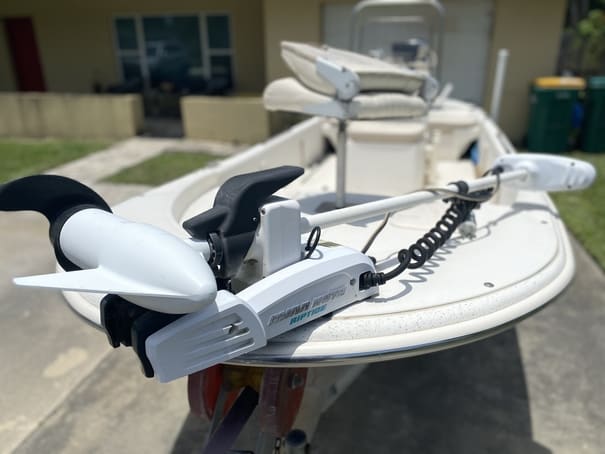
Frequently Asked Questions About Trolling Motors For Carolina Skiffs
Still haven’t got all the information you need to make a choice?
Check out the FAQs below to get a superior insight into trolling motors for Carolina Skiffs.
What Happens If My Trolling Motor Is Too Big For My Carolina Skiff?
A trolling motor cannot be too big for your skiff as long as the shaft length is adjustable. Bigger benefits your boat as it’ll use less power to keep your skiff stationary/trolling slowly along.
The most significant drawback is you’ll pay more for a larger trolling motor.
Can A Trolling Motor Be Too Small For A Carolina Skiff?
Trolling motors can, unfortunately, be underpowered. Depending on the weight of your boat, its size, the hull depth, and the environmental conditions, a trolling motor could quickly find itself over-encumbered and redundant.
Should You Put A Trolling Motor On A Carolina Skiff?
In most situations, you cannot go wrong with a trolling motor. If you have the funds, it is well worth purchasing an appropriately sized trolling motor.
When Would I Use A Trolling Motor On My Carolina Skiff?
Many anglers reap bountiful benefits from their trolling motors; however, the use of one of these small motors is not limited to fishing.
A trolling motor has great versatility when cruising on calm lake waters, maintaining your position in a stream (instead of an anchor), or assisting you with docking.
Can You Equip A Trolling Motor To A Carolina Skiff?
Putting a trolling motor on a Carolina Skiff is certainly possible. These handy little motors are perfect for powering small vessels across short distances without engaging your outboard motor.
What Is The Best Brand Of Trolling Motor?
Each angler has their preference, but quality brand trolling motors include:
- Minn Kota
- Newport
- MotoGuide
Does More Thrust Mean More Speed?
More thrust does not necessarily mean more speed.
Thrust is the power a motor has to fight against the current and wind/the drag of your boat when turning. An increase in thrust does not translate into an increase in overall speed;
However, you’ll have more available power to perform the required tasks.
You May Also Like: Can You Pull A Tube With A Carolina Skiff? Tips To Stay Safe

Growing up in Florida, I’ve been surrounded by saltwater my entire life…and I love sharing my passion with others.
To learn more about why I started Saltwater Mecca, visit the ABOUT page.
Thank you for reading this article. Browse around & have some fun!
